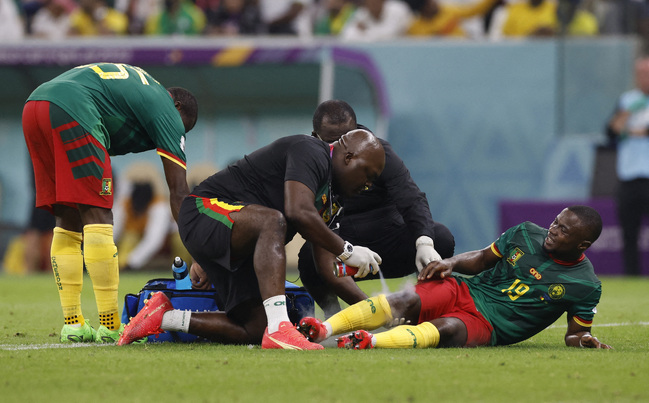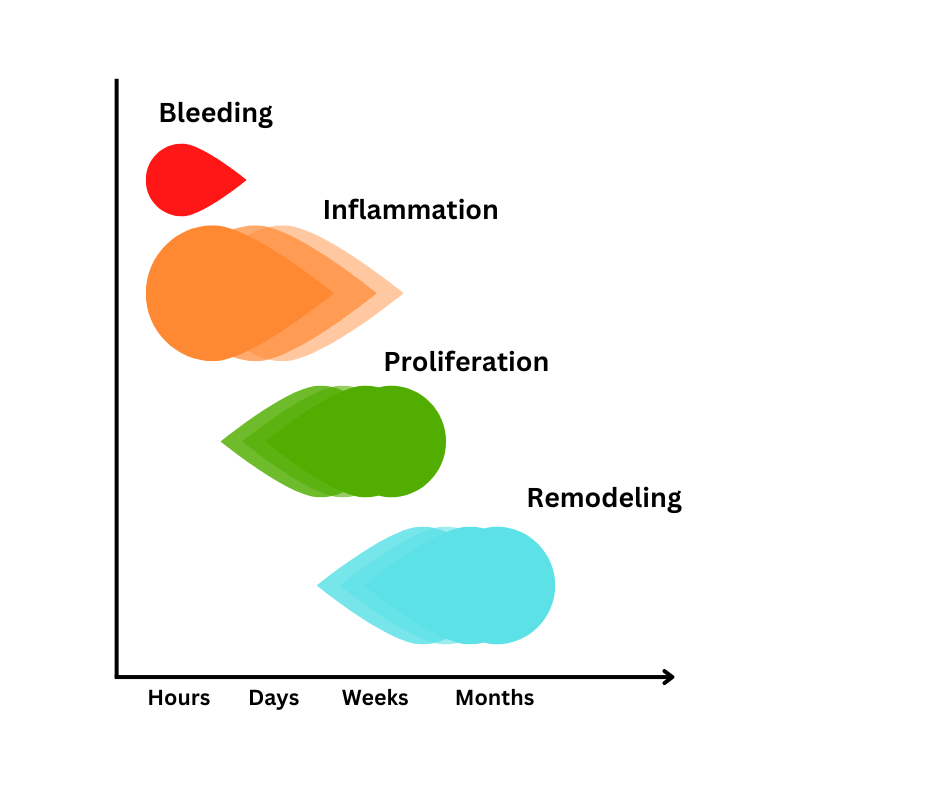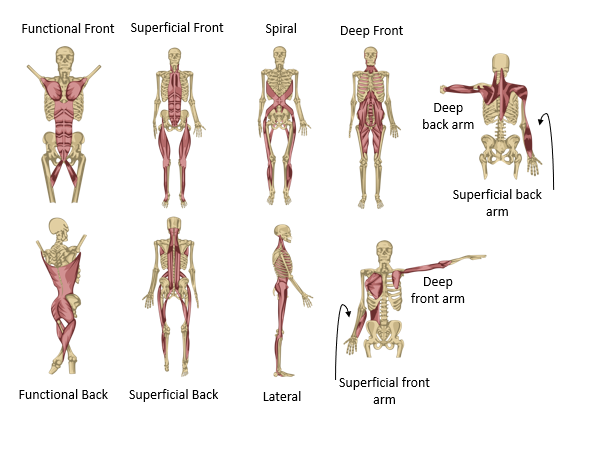You are viewing 1 of your 1 free articles
The Soft Tissue Injury Management Toolbox
There are many approaches to the physiotherapist’s management of soft tissue injuries. Samantha Nupen explores these treatment choices and how to apply them in clinical practice.

Soccer Football - Cameroon v Brazil - Lusail Stadium, Lusail, Qatar - Cameroon’s Collins Fai receives medical attention REUTERS/Amanda Perobelli
The power of touch
Medical professionals are privileged to assist people in finding better health and happiness. This privilege is layered with trust, as patients are willing to share their personal lives with strangers before developing the famed patient-therapist relationship. Physiotherapists are granted the greatest privilege. That is the privilege of touch. This privilege comes with the responsibility to use touch as effectively as possible when treating patients. Manual therapy carries great power. Before the physiotherapist has even decided which treatment technique to use, the reassurance of touch has triggered the placebo effect(1). Practitioners should maximize and embrace the powerful placebo effect to benefit their patients.
The patient receives so many positive cues from the clinical setting. External cues include the therapist’s tone of voice, verbal suggestion, body language, and the treatment room setting. Internal cues include previous treatment memories, emotions, and the feeling that someone is listening and cares (see figure 1). These all activate a positive effect on treatment expectations. As soon as a patient walks into the physiotherapist’s treatment room, the therapy begins before they have been assessed.
During the Covid-19 Pandemic, the lockdown and social distancing regulations severely restricted physical contact and reconceptualized the positive power of physical contact. Intimate and caring touch positively affects anxiety and feelings of loneliness(3). Often anxiety and loneliness exacerbate a patient’s pain experience. This reinforces the power of touch in the therapist’s toolbox. The power lies in the practitioner’s hands.
Manual therapy technique selection
Choosing manual therapy techniques depends on several factors, not least on the training and skill level of the physiotherapist. A thorough interview and physical examination are essential to make treatment choices. In addition, the subjective information gained regarding the injury mechanism, severity, and stage of healing, needs to be considered when practitioners choose manual therapy techniques.
-
The mechanism of injury
It provides valuable clues as to the structure involved and whether the injury is an overuse or an acute injury. The mechanism of injury also sheds light on contributing factors and the likely response to treatment.
-
The severity of the injury
In acute injuries, a grade one sprain or strain will heal quickly and require the application of more vigorous techniques long before a grade three injury. In overuse injuries, the patient’s response to treatment through the comparable sign reassessment will guide the manual therapy technique choices.
-
The stage of healing
During the initial inflammatory healing stage, there is no collagen bridging. Weak type III collagen is laid down only as the healing process moves into the repair/proliferation stage. This progressively strengthens and becomes stronger type I collagen.
Related Files
The toolbox
-
Transverse Frictions
James Cyriax first published his Textbook of Orthopaedic Medicine in 1944(4). He described deep transverse frictions as the treatment for tendon, ligament, and muscle injuries. At the time of publication, soft tissue injury physiology and healing knowledge were limited, and Cyriax made many assumptions. Essentially the reasoning behind deep transverse frictions was to separate the fibers of the injured structure so that they did not heal tethered to other structures or in a shortened position. Deep transverse friction was the manual therapy treatment of choice for a long time. However, more recent evidence, including an extensive 2014 Cochrane review of deep transverse friction massage for treating lateral elbow or lateral knee tendinitis, found no persuasive evidence of the benefit of deep transverse frictions(5).
If we consider the physiology of healing, jumping in with “the forearms of a gorilla and unbridled sadism!” as suggested in the 3rd edition of the Lore of Running, is clearly not the answer(6). This would disrupt the fragile fibrin network laid down to heal the injury and set the patient back. However, in the case of a chronic, stubborn, immobile scar, there is a place for transverse friction because the whole point is to disrupt the tethered fibers and scar.
-
Trigger point therapy(6)
Travell and Simons published their Trigger Point Manuals for the Management of Myofascial Pain and Dysfunction for the Upper and Lower Limbs in 1983. These manuals are an extensive guide to trigger point mapping and treatment with ischemic compression, stretch, and injection techniques. However, the presence of trigger points in a muscle is often a symptom of another issue. Without resolving the other problem, trigger points will persist. The manual therapy techniques described by Travell and Simons are hugely valuable tools in the physiotherapist’s toolbox for assessment and treatment. Trigger-point therapy requires practitioner palpation and subjective feedback from the patient to ensure accurate treatment, such as ischemic compression, focused stretching, and dry needling (instead of injection) that provide substantial relief for patients.
-
Myofascial release(7)
The work that Thomas Myers has done to unravel the mysteries of the myofascial system has provided practitioners with much insight into how to manage soft tissue injuries from a global viewpoint. The network of myofascia in our bodies is truly spectacular. This very special structure is continuous from the top of our heads to the tips of our toes and greatly influences muscle function, posture, and general well-being. A healthy myofascial system should be flexible, mobile, and pliant.
Myers’ description of anatomical lines or trains shifts our focus to address an injury as part of the whole. Ida Rolf (Rolfing) and Benita de Witt, with Lynotherapy, have pioneered myofascial release techniques(9,10). The general principle is to address the global factors along the myofascial lines, and as the myofascia responds to treatment, the treatment becomes more local and specific. Excellent manual therapy skills are essential, and the physiotherapist needs to be sympathetic to the changes happening under their hands. Feeling myofascia releasing is equally satisfying for the patient and the physiotherapist.
-
Specific soft tissue mobilizations(8)
Physiotherapists frequently use specific soft tissue mobilisations (SSTMs) without even knowing it. Glenn Hunter’s paper, Specific Soft Tissue Mobilizations in the Management of Soft Tissue Dysfunction, has created some structure for these techniques. Specific soft tissue mobilizations are described as either physiological, accessory, combined, or dynamic. Practitioners can use SSTMs to assess and manage soft tissue injuries.
Excellent manual therapy skills are essential as physiotherapist searches for even subtle clues under their hands. With sound clinical reasoning, constant reassessment, and creative thinking, the sky is the limit with SSTMs.
Conclusion
There are many manual therapy skills available to physiotherapists. This article has only touched on a few but has hopefully stimulated enough interest to explore the many wonderful ways to manage soft tissue injuries. An accurate assessment of the patient and their presentation is essential. Practitioners should manage the contributing factors, work globally and locally, and, most importantly, clinically reason. The power is truly in the hands of the practitioner.
References
- Nat Rev Neurosci. 2015 Jul; 16(7): 403–418
- J Man Manip Ther. 2011; 19(1): 11-19
- R Soc Open Sci.2021 Sep; 8(9): 210287
- Baillière Tindall, 1982. Textbook of Orthopaedic Medicine. Vol 1 Diagnosis of Soft Tissue Lesions, 8th Edition
- Cochrane Database Syst Rev.2014 Nov; 2014(11): CD003528
- Oxford University Press, 1992. Lore of Running, 3rd
- Williams & Wilkins, 1999. Myofascial Pain and Dysfunction, The Trigger Point Manual, Vol 1, 2nd Edition
- Churchill Livingstone, 2009. Anatomy Trains, 2nd
- www.rolf.org/history.php
- thelynomethod.com/
- 1994 Jan; 80(1): 15-21
Newsletter Sign Up
Subscriber Testimonials
Dr. Alexandra Fandetti-Robin, Back & Body Chiropractic
Elspeth Cowell MSCh DpodM SRCh HCPC reg
William Hunter, Nuffield Health
Newsletter Sign Up
Coaches Testimonials
Dr. Alexandra Fandetti-Robin, Back & Body Chiropractic
Elspeth Cowell MSCh DpodM SRCh HCPC reg
William Hunter, Nuffield Health
Be at the leading edge of sports injury management
Our international team of qualified experts (see above) spend hours poring over scores of technical journals and medical papers that even the most interested professionals don't have time to read.
For 17 years, we've helped hard-working physiotherapists and sports professionals like you, overwhelmed by the vast amount of new research, bring science to their treatment. Sports Injury Bulletin is the ideal resource for practitioners too busy to cull through all the monthly journals to find meaningful and applicable studies.
*includes 3 coaching manuals
Get Inspired
All the latest techniques and approaches
Sports Injury Bulletin brings together a worldwide panel of experts – including physiotherapists, doctors, researchers and sports scientists. Together we deliver everything you need to help your clients avoid – or recover as quickly as possible from – injuries.
We strip away the scientific jargon and deliver you easy-to-follow training exercises, nutrition tips, psychological strategies and recovery programmes and exercises in plain English.













